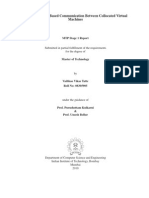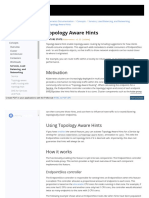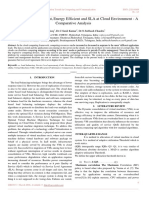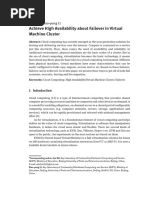0 ratings0% found this document useful (0 votes)
46 viewsSFC10
SFC10
Uploaded by
Sagar Talla1) The document investigates virtual network performance on the Xen platform and examines how CPU allocation impacts forwarding rates of virtual routers.
2) Experiments show that assigning a single CPU core to Domain 0 provides the best forwarding performance, while sharing cores degrades performance.
3) The credit scheduler's "cap" parameter can be used to control each virtual router's packet forwarding rate by adjusting the percentage of CPU resources allocated. Adjusting caps allows guaranteeing different performance levels for each virtual router.
Copyright:
Attribution Non-Commercial (BY-NC)
Available Formats
Download as PDF, TXT or read online from Scribd
SFC10
SFC10
Uploaded by
Sagar Talla0 ratings0% found this document useful (0 votes)
46 views1 page1) The document investigates virtual network performance on the Xen platform and examines how CPU allocation impacts forwarding rates of virtual routers.
2) Experiments show that assigning a single CPU core to Domain 0 provides the best forwarding performance, while sharing cores degrades performance.
3) The credit scheduler's "cap" parameter can be used to control each virtual router's packet forwarding rate by adjusting the percentage of CPU resources allocated. Adjusting caps allows guaranteeing different performance levels for each virtual router.
Copyright
© Attribution Non-Commercial (BY-NC)
Available Formats
PDF, TXT or read online from Scribd
Share this document
Did you find this document useful?
Is this content inappropriate?
1) The document investigates virtual network performance on the Xen platform and examines how CPU allocation impacts forwarding rates of virtual routers.
2) Experiments show that assigning a single CPU core to Domain 0 provides the best forwarding performance, while sharing cores degrades performance.
3) The credit scheduler's "cap" parameter can be used to control each virtual router's packet forwarding rate by adjusting the percentage of CPU resources allocated. Adjusting caps allows guaranteeing different performance levels for each virtual router.
Copyright:
Attribution Non-Commercial (BY-NC)
Available Formats
Download as PDF, TXT or read online from Scribd
Download as pdf or txt
0 ratings0% found this document useful (0 votes)
46 views1 pageSFC10
SFC10
Uploaded by
Sagar Talla1) The document investigates virtual network performance on the Xen platform and examines how CPU allocation impacts forwarding rates of virtual routers.
2) Experiments show that assigning a single CPU core to Domain 0 provides the best forwarding performance, while sharing cores degrades performance.
3) The credit scheduler's "cap" parameter can be used to control each virtual router's packet forwarding rate by adjusting the percentage of CPU resources allocated. Adjusting caps allows guaranteeing different performance levels for each virtual router.
Copyright:
Attribution Non-Commercial (BY-NC)
Available Formats
Download as PDF, TXT or read online from Scribd
Download as pdf or txt
You are on page 1of 1
1
CPU Allocation on Xen Virtual Networks
Rodrigo S. Couto, Hugo E. T. Carvalho, Lyno Henrique G. Ferraz,
Miguel Elias M. Campista, Luı́s Henrique M. K. Costa and Otto Carlos M. B. Duarte
Grupo de Teleinformática e Automação - PEE/COPPE - DEL/POLI
Universidade Federal do Rio de Janeiro - Rio de Janeiro, Brazil
Email:{souza,hugo,lyno,miguel,luish,otto}@gta.ufrj.br
Abstract—In this work we investigate virtual network per- (TRs) passing through a traffic forwarder (TF). All machines
formance using Xen. We perform experiments using scheduling run Debian Linux and TF runs Xen 3.4.2 system.
parameters and static CPU allocation. Results indicate that the
forwarding packet rate of each virtual router can be controlled A. Domain 0 CPU cores
by adjusting CPU scheduling parameters. All packets destined to virtual routers must pass through
I. I NTRODUCTION Domain 0. Thus, we need first to evaluate the performance
The growing need to develop pluralist architectures for the of Domain 0 adjusting the number of CPU cores allocated
future Internet leads to the use of virtual routers in platforms to it. In this experiment, we send packets from one of the
such as Xen [1]. Xen implements a software layer called VMM TGs to one of the TRs at a fixed rate and vary the number
(Virtual Machine Monitor) which controls how virtual ma- of CPU cores allocated to Domain 0. We run this test for
chines, called Domains, access hardware resources. Domain 0 up to four virtual machines forwarding packets and sharing
is a special Domain that implements an interface between the same TF physical network interfaces. On the one hand,
abstract devices within virtual machines and physical devices. the performance of packet forwarding is severely impacted
In the case of networking, packets destined to unprivileged when all Domains share one CPU core because of the high
Domains must pass through Domain 0 before reaching virtual contention for CPU resources. On the other hand, the best
interfaces. This communication between Domain 0 and other performance is achieved when Domain 0 has one exclusive
Domain imposes limitations to network tasks due to high CPU core. Surprisingly, assigning more cores to Domain 0 results
consumption. Moreover, in Xen environment the Domains in performance degradation in our scenario. This result shows
share physical resources, including CPU. In this paper, we that the tasks that Domain 0 executes to forward packets
aim at analyzing the impact of CPU resource allocation on through virtual machines are single-threaded and that these
virtual routers performance. tasks are not well suitable for multi-core environments. The
behavior observed in this test is independent of the number of
II. X EN C REDIT S CHEDULER
virtual machines concurrently forwarding packets.
For each Domain running on a Xen environment is assigned
B. Cap Adjustment
a number of Virtual CPUs (VCPUs). These VCPUs correspond
Credit Scheduler parameters can be used to offer different
to the CPUs that the running processes in a Domain can see.
service levels to virtual routers. In our case, we use the cap
Xen implements the Credit Scheduler to manage CPU time
to show how packet rate can be adjusted when the system
given to each Domain. This scheduler dynamically allocates
administrator has control of CPU resource sharing among
a physical CPU core to each VCPU for a certain amount of
virtual routers. The experiment consists in sending packets
time. In Xen platform the administrator can also manually
from a TG to TR at a fixed rate through each virtual router
allocate a CPU core to a VCPU of a certain Domain but cannot
in TF. In this experiment, TF has two virtual routers with
guarantee if another VCPUs will share the same core. The
each one having its own network interface pair and sharing
basic idea of Xen Credit Scheduler is to assign credits to each
the same CPU core. Thus, we ensure that the main resource
Domain based on two parameters: weight and cap. Each time a
that the virtual routers are sharing is the CPU. Domain 0 in
Domain executes, i.e. each of its VCPUs, it consumes credits.
this case has its own CPU core.
Based on credit accounting, the scheduler determines which
In this experiment we assign a fixed cap of 100 to a
VCPU can run. The weight determines the share of CPU time
virtual machine (VM2) and vary the cap of the other virtual
each Domain can get and doesn’t represent an upper-limit, i.e
machine (VM1). Results show that the performance of VM1
Domains can use more than its share when CPU is idle. The
decreases when its cap is reduced whereas VM2 performance
cap, in turn, is an absolute value that represents a percentage
increases. Thus, we show that we can assure certain perfor-
of CPU a Domain can use, i.e cap=50 is half CPU. The cap
mance level to each virtual router, merely adjusting the cap.
gives more control to the system administrator about the CPU
Our future work aims at building a mechanism to dynamically
usage by the Domains.
adjust caps depending on each Domain performance level.
III. P ERFORMANCE E VALUATION
R EFERENCES
We aim at analyzing how Domain 0 CPU allocation impacts
[1] P. Barham, B. Dragovic, K. Fraser, S. Hand, , T. Harris, A. Ho, R. Neuge-
forwarding performance and how can a system administrator bauer, I. Pratt, and A. Warfield, “Xen and the art of virtualization,” in
manage CPU resources to guarantee a certain throughput to ACM SOSP, Oct. 2003, pp. 164–177.
a virtual router. To accomplish this, we conduct two experi- ACKNOWLEDGMENT
ments. These experiments were carried out in a testbed with This work was supported by CNPq, CAPES, FINEP, FUNTTEL, and
traffic generators (TGs) sending packets to traffic receivers FAPERJ.
You might also like
- Essay Beasiswa Dea VdmiDocument2 pagesEssay Beasiswa Dea VdmiEdial LapasNo ratings yet
- Effective VM Scheduling Strategy For Heterogeneous Cloud EnvironmentDocument3 pagesEffective VM Scheduling Strategy For Heterogeneous Cloud EnvironmentbudhNo ratings yet
- Networking Performance MicrokernelsDocument6 pagesNetworking Performance MicrokernelsBruno FissNo ratings yet
- Photon ConfigurationDocument4 pagesPhoton Configurationshiro yashaNo ratings yet
- HW 3Document14 pagesHW 3owen0928092110No ratings yet
- Unit - Ii: Communication and InvocationDocument16 pagesUnit - Ii: Communication and InvocationmdayyubNo ratings yet
- Load Sharing With OCGRR For Network Processors Which Supports Different ServicesDocument6 pagesLoad Sharing With OCGRR For Network Processors Which Supports Different Serviceseditor2533No ratings yet
- Shared Memory Based Communication Between Collocated Virtual MachinesDocument24 pagesShared Memory Based Communication Between Collocated Virtual MachinesDmitry StarikovNo ratings yet
- Communication and InvocationDocument14 pagesCommunication and InvocationARVINDNo ratings yet
- 38-Kubernetes Io Docs Concepts Services Networking Topology AwaDocument6 pages38-Kubernetes Io Docs Concepts Services Networking Topology AwaArmstrong NoriscaNo ratings yet
- High Performance ComputingDocument61 pagesHigh Performance ComputingShrey Thakur100% (2)
- Measuring CPU Overhead For I/O Processing in The Xen Virtual Machine MonitorDocument4 pagesMeasuring CPU Overhead For I/O Processing in The Xen Virtual Machine MonitorJacinto José FrancoNo ratings yet
- Design Routing Protocols For Mobile Ad Hoc NetworksDocument6 pagesDesign Routing Protocols For Mobile Ad Hoc NetworksSreeni ChampNo ratings yet
- Quantifying The Cost of Context SwitchDocument4 pagesQuantifying The Cost of Context Switchreg2regNo ratings yet
- Solution cs66 Week 03 Assignment 03Document3 pagesSolution cs66 Week 03 Assignment 03karolee2No ratings yet
- Computer Communications: Francisco J. Ros, Pedro M. RuizDocument11 pagesComputer Communications: Francisco J. Ros, Pedro M. RuizXuehan YeNo ratings yet
- 2 1520673200 - 10-03-2018 PDFDocument8 pages2 1520673200 - 10-03-2018 PDFEditor IJRITCCNo ratings yet
- Unit 1 CloudDocument102 pagesUnit 1 CloudChetha SpNo ratings yet
- fastpw13-final29Document2 pagesfastpw13-final296kitsune66No ratings yet
- A TCP Fairness Control Method For Two-Host Concurrent Communications in Elastic WLAN System Using Raspberry Pi Access-PointDocument5 pagesA TCP Fairness Control Method For Two-Host Concurrent Communications in Elastic WLAN System Using Raspberry Pi Access-PointBoopathi RNo ratings yet
- Managing_GPU_Concurrency_in_Heterogeneous_ArchitecturesDocument13 pagesManaging_GPU_Concurrency_in_Heterogeneous_Architecturesluzhixing12345No ratings yet
- Sudibyo2019 PDFDocument5 pagesSudibyo2019 PDFBoopathi RNo ratings yet
- Research Article: Scheduling Algorithm: Tasks Scheduling Algorithm For Multiple Processors With Dynamic ReassignmentDocument10 pagesResearch Article: Scheduling Algorithm: Tasks Scheduling Algorithm For Multiple Processors With Dynamic ReassignmentSirajul IslamNo ratings yet
- Vsphere Challenge LabDocument4 pagesVsphere Challenge LabsivakumarNo ratings yet
- DPDK - Inter-Container CommunicationsDocument12 pagesDPDK - Inter-Container CommunicationsЛиля БуторинаNo ratings yet
- Software-Defined Networking: Reconfigurable Network Systems in LAN TopologyDocument5 pagesSoftware-Defined Networking: Reconfigurable Network Systems in LAN TopologyMuhammad RaflyNo ratings yet
- Module - 6Document89 pagesModule - 6anjuNo ratings yet
- Kubernates Cluster On Centos 8 PDFDocument28 pagesKubernates Cluster On Centos 8 PDFJulio Cesar Agudelo BenitezNo ratings yet
- Raid Soft V HardDocument6 pagesRaid Soft V HardSang Tran MinhNo ratings yet
- SENIC: Scalable NIC For End-Host Rate LimitingDocument14 pagesSENIC: Scalable NIC For End-Host Rate LimitingXANPHOXYL KIBETNo ratings yet
- Ieee OfnetDocument5 pagesIeee OfnetSaleh AsadollahiNo ratings yet
- Energy Consumption Measurements in Docker: 2017 IEEE 41st Annual Computer Software and Applications ConferenceDocument2 pagesEnergy Consumption Measurements in Docker: 2017 IEEE 41st Annual Computer Software and Applications Conferenceadithya adigaNo ratings yet
- Xen Vs KVMDocument6 pagesXen Vs KVMSaravanaRaajaaNo ratings yet
- Network Based Distributed Computing: By:Peter Kacsuk Ferenc Vijad Presented BYDocument22 pagesNetwork Based Distributed Computing: By:Peter Kacsuk Ferenc Vijad Presented BYKrishnendra SinghNo ratings yet
- OVERVIEW of CLUster ComputingDocument6 pagesOVERVIEW of CLUster ComputingKrish RonaldoNo ratings yet
- Case Study of KVM and XenDocument6 pagesCase Study of KVM and XenSneha BendaleNo ratings yet
- Comp Sci - IJCSEITR - POLVMParallel Optimized Live VM Migration - Jayasree PDocument16 pagesComp Sci - IJCSEITR - POLVMParallel Optimized Live VM Migration - Jayasree PTJPRC PublicationsNo ratings yet
- Mpls Layer 2 Vpns Sample Test Plans: Functional and Performance TestingDocument16 pagesMpls Layer 2 Vpns Sample Test Plans: Functional and Performance TestingbgpexpertNo ratings yet
- IrvanNugroho 3859Document4 pagesIrvanNugroho 3859Diah Ayu Kurnia watiNo ratings yet
- Irtual Pts TestDocument7 pagesIrtual Pts TestКирилл СимоновNo ratings yet
- HW1Document2 pagesHW1kkihumbaNo ratings yet
- SLO-Aware_GPU_DVFS_for_Energy-Efficient_LLM_Inference_ServingDocument4 pagesSLO-Aware_GPU_DVFS_for_Energy-Efficient_LLM_Inference_Servinghowickitcyotara88000No ratings yet
- Performance of Firefly RPCDocument18 pagesPerformance of Firefly RPCdonnal47No ratings yet
- Poster SOFT2018 BSantos Linux Device DriverDocument1 pagePoster SOFT2018 BSantos Linux Device DriverNuno CruzNo ratings yet
- International Research Journal of EngineDocument7 pagesInternational Research Journal of EnginefaruqoluwaseyiolayinkaNo ratings yet
- Virtual Machine Migration Planning in Software-Defined NetworksDocument10 pagesVirtual Machine Migration Planning in Software-Defined NetworksHamza SaadNo ratings yet
- Energy Efficient Scheduling of Servers With Multi-Sleep Modes For Cloud Data CenterDocument14 pagesEnergy Efficient Scheduling of Servers With Multi-Sleep Modes For Cloud Data CenterrajNo ratings yet
- cs516 Unit IIDocument24 pagescs516 Unit II321106410027No ratings yet
- Virtualization With KVM and LibvirtDocument7 pagesVirtualization With KVM and LibvirtsofiawalgodecarranchoNo ratings yet
- Distributed Systems: Practice ExercisesDocument4 pagesDistributed Systems: Practice Exercisesijigar007No ratings yet
- Evolution of New Efficient Load Balancer Algorithm For Large Data SetsDocument10 pagesEvolution of New Efficient Load Balancer Algorithm For Large Data SetsTJPRC PublicationsNo ratings yet
- Introduction To Networks Version 70 ITNv7 Practice Final Exam AnswersDocument27 pagesIntroduction To Networks Version 70 ITNv7 Practice Final Exam AnswersTemam MohammedNo ratings yet
- Masakari HADocument10 pagesMasakari HAmetaNo ratings yet
- Trumpet Event ManagerDocument15 pagesTrumpet Event Managerkashyap.karthikNo ratings yet
- A Modular Quantum Compilation Framework For Distributed Quantum ComputingDocument13 pagesA Modular Quantum Compilation Framework For Distributed Quantum Computingchaminu456No ratings yet
- CENTRALA TELEFONICA OpenScape 4000 Systems Components (394-419)Document26 pagesCENTRALA TELEFONICA OpenScape 4000 Systems Components (394-419)Casian Ionut MoldovanNo ratings yet
- 23 - An - Analysis of The Performance - of - Websockets - in - Various - Programming - Languages - and - LibrariesDocument7 pages23 - An - Analysis of The Performance - of - Websockets - in - Various - Programming - Languages - and - Librariesso.ghost.07No ratings yet
- Portland Sigc09 PDFDocument12 pagesPortland Sigc09 PDFJohn YuanNo ratings yet
- Sank Eth Beer AbiDocument26 pagesSank Eth Beer AbiKUNGYAVA ENTERTAINMENTSNo ratings yet
- Next-Generation switching OS configuration and management: Troubleshooting NX-OS in Enterprise EnvironmentsFrom EverandNext-Generation switching OS configuration and management: Troubleshooting NX-OS in Enterprise EnvironmentsNo ratings yet
- Calculating RAROC For The Corporate Accounts in Bank of BarodaDocument20 pagesCalculating RAROC For The Corporate Accounts in Bank of Barodajagjeetkumar178% (9)
- ReportDocument3 pagesReportNabeel KhanNo ratings yet
- Keieikeizai66 02 04Document17 pagesKeieikeizai66 02 04Kajankumar PerumalNo ratings yet
- Bahasa Inggris Kep ch.2Document12 pagesBahasa Inggris Kep ch.2Alfira CahyaNo ratings yet
- 1LE7501-1BB23-5FA4 Datasheet enDocument1 page1LE7501-1BB23-5FA4 Datasheet enTony TonyNo ratings yet
- Point of Sales Terminal (Post) Using Uml: February 2018Document24 pagesPoint of Sales Terminal (Post) Using Uml: February 2018hitzandyNo ratings yet
- Grade V Unit # 7 PracticeDocument4 pagesGrade V Unit # 7 PracticeHameed RehmanNo ratings yet
- Phulkian State GazzetterDocument409 pagesPhulkian State Gazzetteruday shardaNo ratings yet
- A and An With Key - 67319Document2 pagesA and An With Key - 67319RIEE50% (2)
- Research M5Document2 pagesResearch M5Cindy GeverolaNo ratings yet
- Teaching Demo RubricDocument2 pagesTeaching Demo RubricBeverage A. SarzaNo ratings yet
- Maximino Carantes vs. CA, G.R. No. L-33360, April 25, 1977Document5 pagesMaximino Carantes vs. CA, G.R. No. L-33360, April 25, 1977Sarah Jane-Shae O. SemblanteNo ratings yet
- Related StudiesDocument4 pagesRelated StudiesAngeline LedeirreNo ratings yet
- Resume CritiqueDocument4 pagesResume CritiqueCynthia TranNo ratings yet
- Screenshot 2022-03-14 at 11.11.35 AMDocument1 pageScreenshot 2022-03-14 at 11.11.35 AMnicolergatdulaNo ratings yet
- StalinKv ResumeDocument3 pagesStalinKv ResumeMadhan ReddyNo ratings yet
- "Not Only A Musician of A Generation, He Is A Cultural Hero"-Vibert CambridgeDocument3 pages"Not Only A Musician of A Generation, He Is A Cultural Hero"-Vibert CambridgeAnonymous hWHYwX6No ratings yet
- Lecture - German Consonant PronunciatonDocument7 pagesLecture - German Consonant PronunciatonSophiaNo ratings yet
- Opinion EssayDocument1 pageOpinion EssayAlex Marcos FlaviaNo ratings yet
- Week 7-8Document17 pagesWeek 7-8Roshin TejeroNo ratings yet
- Test Bank Intacc InventoriespdfDocument344 pagesTest Bank Intacc InventoriespdfRNo ratings yet
- Reit PPT Vornado Realty Trust PresentationDocument42 pagesReit PPT Vornado Realty Trust PresentationDaniel GoytrNo ratings yet
- Steel BaleDocument15 pagesSteel BaleRisman YusufNo ratings yet
- Entrepreneurship Development Institute of India (EDI)Document9 pagesEntrepreneurship Development Institute of India (EDI)apekshagoreNo ratings yet
- Emergencies For Oil and Chemical TankersDocument6 pagesEmergencies For Oil and Chemical TankersD kuiNo ratings yet
- Reading ComprehensionDocument20 pagesReading ComprehensionmterranoNo ratings yet
- قراءة في واقع منظومة التعليم العالي بالجزائر في ظل إصلاحات نظام (ل م د)Document23 pagesقراءة في واقع منظومة التعليم العالي بالجزائر في ظل إصلاحات نظام (ل م د)Adel BouafiaNo ratings yet
- 220089enb Generator DesignDocument58 pages220089enb Generator DesignMahmoud ElboraeNo ratings yet
- Novum IQ Syringe Brochure 0Document5 pagesNovum IQ Syringe Brochure 0svetlana123197No ratings yet

























































































